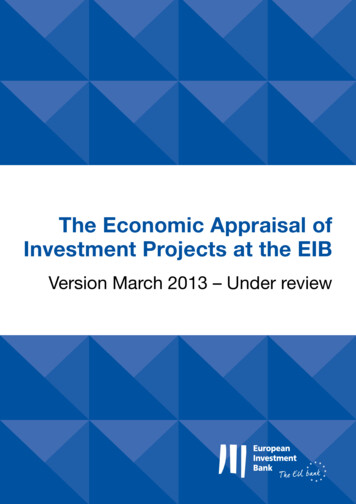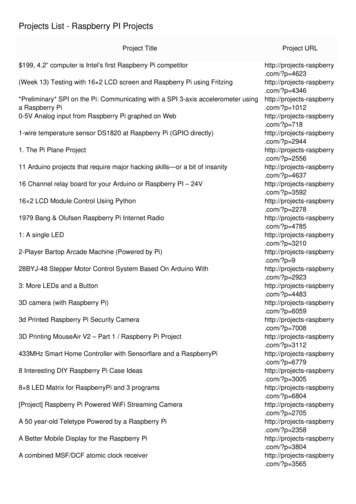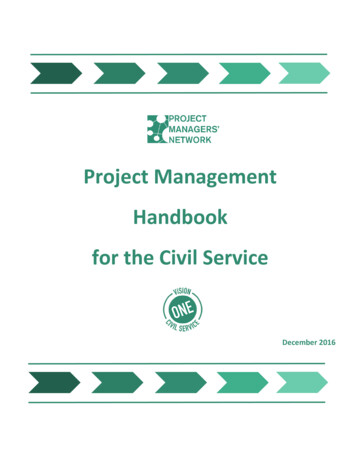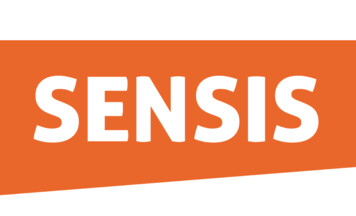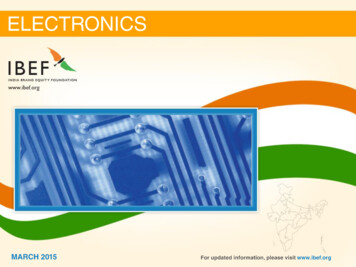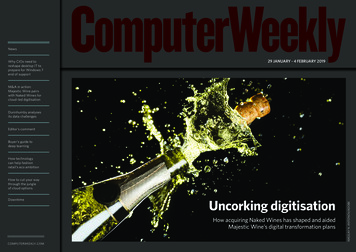
Transcription
MANAGEMENT OF DIGITISATION PROJECTS IN NIGERIANUNIVERSITY LIBRARIESBYMOHAMMED, MOHAMMED KPAKIKOMSC/EDUC/02398/2010-2011A THESIS SUBMITTED TO THE POSTGRADUATE SCHOOL,AHMADU BELLO UNIVERSITY, ZARIAIN PARTIAL FULFILLMENT FOR THE AWARD OF DEGREE OFMASTER OF INFORMATION SCIENCEDEPARTMENT OF LIBRARY AND INFORMATION SCIENCEFACULTY OF EDUCATIONAHMADU BELLO UNIVERSITY,ZARIADECEMBER, 2014
DECLARATIONI declare that this thesis titled “Management of Digitisation Projects in NigerianUniversity Libraries” has been written by me under the supervision of Professor ZakariMohammed and Dr Ezra S, Gbaje. The information derived from the literature has been dulyacknowledged in the text and a list of references provided. No part of this thesis waspreviously presented for any form of degree or Diploma at any University.MOHAMMED MOHAMMED KPAKIKO ----------------------------- -------------------------Name of StudentSignatureDateii
CERTIFICATIONThis is to certify that this thesis titled “Management of Digitisation Projects in NigerianUniversity Libraries” by Mohammed Mohammed Kpakiko has met the requirementsgoverning the award of the degree of Masters in Information Science of Ahmadu BelloUniversity, Zaria and is hereby approved for its contributions to knowledge.Prof. Zakari MohammedChairman, Supervisory CommitteeDateDr. Ezra S. GbajeMember, Supervisory CommitteeDateAbdullahi I. Musa PhDHead of DepartmentDateProf. Adebayo A. JoshuaDean, Postgraduate SchoolDateiii
DEDICATIONThis work is dedicated to Allah Almighty and to my family members for their support andencouragement.iv
ACKNOWLEDGEMENTFirst and foremost, my sincere gratitude goes to Almighty Allah for the blessings, mercyand good health bestowed on me throughout this academic venture. And to my twosupervisors, Professor Zakari Mohammed and Dr Ezra Shiloba Gbaje, words are not enoughto express my heartfelt gratitude for creating time despite their tight scholastic schedules togo through every single line of this research work and offered useful suggestions from theirwealth of experiences to make this scholarly rich. May Allah Almighty reward youabundantly.I also, want to register my sincere appreciation to all lecturers in the department ofLibrary and Information Science Ahmadu Bello University, Zaria, for their wonderfulcontributions to enrich this research work. This work, no doubt was an efforts of team workof the entire academic staff of the department.To my family, you are wonderful to me. I say I love you all. Mal. Hashimu Suleiman(Chief Librarian, College of Education, Sokoto) you are indeed a worthy course mate. Thankyou for all your support and May Allah grant you long life and good health. And to all mycourse mates too numerous to mention, I say thank you all.v
ABSTRACTThe study Management of Digitisation Projects in Nigerian University Libraries was conducted toassess how digitisation projects are being managed in Nigerian University Libraries. This is becauseefforts are being put forward to improve on the information resource handling and management frombeing manually driven to electronic driven especially in Libraries and Information centers whereinformation bearing mediums were originally in printed formats. And as such a particular librarycould not participate effectively in the information sharing methods that can be facilitated bydigitisation. Four objectives were achieved by formulating and answering four research questions forthe study. The objectives were to find out the skill sets available for managing digitisation projects inNigerian university libraries, identify the types of information resources that are being digitized, findout the criteria that are being used for the selection digital asset management software and to assessdigital preservation policy and strategies that are employed in the management of digitisation projectsin Nigerian university libraries, Survey method was adopted for the study. The research instrumentsused to collect data for the study were questionnaire and interview. Since the whole population for thestudy is 40, all of them were used. That is 8 subjects from Ahmadu Bello University, Zaria, 8 fromUniversity of Jos, 6 from Covenant University, Ota, 11 fron University of Nigeria, Nsukka and 7 fromFederal University of Technology, Akure. Data were presented in frequency tables and percentages.Analysis and discussions were made to each table. Findings of the study revealed that majority of staffthat engaged in digitisation project management are librarians who possess the ability to use softwarepackages like Abbyfine reader, Omnipage and PDF respectively. Again the finding revealed that alluniversities where digitisation project is going on emphasize mostly on PhD dissertations, Masterstheses and university Journal articles whose copyright have been obtained. That many universitiesconsider open source criteria, functionality, interoperability, scalability and extensibility as criteria forselecting digital asset management software, principle statement, contextual link, preservationobjectives and identification content were the major policy elements The study concluded thatinadequate staff skill sets possessed by the digitisation staff and the digitisation managementstakeholders impedes digitisation project management best practices in Nigerian university libraries.Based on these findings several recommendations were made such as librarians, system analysts andarchivists should be awarded short and long-time training or courses to acquire more skills, Universitylibraries in Nigeria should focus their digitisation project on local contents such as dissertations,theses, journal articles and university journals. They should be committed to a substantial investmentin keeping pace with open source digital asset management software for managing digitisationprojects and there is need for a written policy document that will help to focus the digitisation projectmanagement.vi
TABLE OF CONTENTSTITLE PAGE ------------------------------------------- iDECLARATION -------------------------------------- iiCERTIFICATION ------------------------------------ iiiDEDICATION ---------------------------------------- ivACKNOWLEDGEMENT ---------------------------- vABSTRACT ------------------------------------------- viTABLE OF CONTENTS --------------------------- viiCHAPTER ONE: INTRODUCTION1.1 Background to the Study ------------------------ 11.2 Statement of the Problem ----------------------- 151.3 Research Questions ------------------------------ 161.4 Objectives of the --------------------------------- 171.5 Significance of the Study ----------------------- 171.6 Assumptions of the Study ---------------------- 181.7 Scope of the Study ------------------------------- 181.8 Operational Definition of Terms -------------- 19RFERENCES ----------------------------------------- 21CHAPTER TWO: REVIEW OF RELATED LITERATURE2.1 Introduction --------------------------------------- 232.2 Skill Sets Available for Managing Digitisation Projects in University Libraries --------- 242.3 Types of Information Resources Digitised in University Libraries ------------------------- 282.4 Criteria for Selection of Asset Management Software for Digitisation Projects inUniversity Libraries ---------------------------- 32vii
2.5 Policies and Strategies Employed for the Management of Digitisation Projects inUniversity Libraries ---------------------------- 372.6 Summary of the Review ----------------------- 43REFERENCES --------------------------------------- 44CHAPTER THREE: METHODOLOGY3.1 Introduction -------------------------------------- 473.2 Research Methodology Adopted for the Study ------------------------------------------------ 473.3 Population of the Study ------------------------- 483.4 Sample and Sampling Technique -------------- 493.5 Instrument for Data Collection ---------------- 493.5.1 Validity of the Research Instrument -------- 513.6 Procedure for Collection ------------------------ 513.7 Procedure for Data Analysis ------------------- 51REFERENCES --------------------------------------- 52CHAPTER FOUR: DATA PRESENTATION, ANALYSIS AND DISCUSSION4.1 Introduction --------------------------------------- 534.2 Response Rate ------------------------------------ 534.2.1 Demographic Features of Respondents ----- 544.3 Data Analysis ------------------------------------ 564.3.1 Skill sets for Digitisation Projects in Nigerian University Libraries --------------------- 564.3.2 Types of Information Resources Being Digitised in Nigerian University Libraries --- 594.3.2.1 Criteria for Selecting Information Resources for Digitisation -------------------------- 624.3.3 Criteria for Selection of Digital Asset Management Software for Digitisation Projects inNigerian University Libraries ---------------------- 65viii
4.3.3.1 Digital Asset Management Software Adopted for Digitisation Projects in NigerianUniversity Libraries ---------------------------------- 684.3.4 Policies and Strategies Employed for the Management of Digitisation Projects inNigerian University Libraries ---------------------- 714.3.4.1 Policy Elements Employed for the Management of Digitisation Projects in NigerianUniversity Libraries ---------------------------------- 74REFERENCES -------------------------------------- 78CHAPTER FIVE: SUMMARY, CONCLUSION AND RECOMMENDATIONS5.1 Introduction ------------------------------------- 795.2 Summary of the Study ------------------------- 795.3 Summary of Findings -------------------------- 805.4 Conclusion -------------------------------------- 815.5 Recommendations ------------------------------ 815.6 Recommendations for Further Studies ------ 82BIBLIOGRAPHY ---------------------------------- 84APPENDIX A --------------------------------------- 91APPENDIX B --------------------------------------- 92APPENDIX C --------------------------------------- 98ix
LIST OF TABLESTable 2.1 Showing Application Software for Digitisation Project -------------------------- 33Table 3.1 Distribution of Digitisation Staff Population from the Institutions Understudy ----- 49Table 4.1 Response Rate ------------------------ 53Table 4.2 Distribution of Respondents by Demographic Characteristics ------------------ 55Table 4.3 Skill Sets for the Management of Digitisation Project in Nigerian UniversityLibraries ------------------------------------------- 57Table 4.4 Types of Information Resources Digitised in Nigerian University Libraries - 60Table 4.5 Criteria for Selecting Information Resources for Digitisation ------------------- 63Table 4.6 Criteria for Selection of Digital Asset Management Software for DigitisationProject in Nigerian University Libraries ------ 66Table 4.7 Digital Asset Management Software Adopted for Digitisation Projects inNigerian University Libraries ------------------ 69Table 4.8 Availability of Digitisation management Policy ---------------------------------- 72Table 4.9 Policy Elements Employed for the Management of Digitisation Project inNigerian University Libraries ------------------ 75x
LIST OF FIGURESFigure 4.1 Response Rates of Respondents ------- 54Figure 4.2 Distributions of Responses on the Skill Sets for Digitisation Project Managementin Nigerian University Libraries ------------------- 58Figure 4.3 Distributions of Responses on the Types of Information Resources Digitised inNigerian University Libraries ---------------------- 61Figure 4.4 Distributions of Responses on the Criteria for Selecting Information Resources forDigitisation in Nigerian University Libraries ---- 64Figure 4.5 Distributions of Responses on the Criteria Used for Selection of Digital AssetManagement Software for Digitisation Projects in Nigerian University Libraries ------------ 67Figure 4.6 Distributions of responses on Digital Asset Management Software Adopted forDigitisation Project in Nigerian University Libraries --------------------------------------------- 70Figure 4.7 Distributions of Responses on the Availability of Digitisation Management --------------- 73Figure 4.8 Distributions of Responses on Digital Preservation policy Elements Employed forthe Management of Digitisation Projects in Nigerian University Libraries -------------------- 76xi
CHAPTER ONEINTRODUCTION1.1 Background to the StudyRecent development in the world of information resource handling and managementhave moved from being manually driven to electronic driven especially in Libraries,Information centers, Museums and Archival centers where information bearing media wereoriginally in printed formats. The need to source and present information for academicpurpose is a daily routine for university libraries all over the world. Digitisation of librarycollections is a common phenomenon amongst academic and research institutions because itimproves access and preservation of information resources. Libraries are making effort toconvert text and images of their local and rare materials into digital formats so that they canbe available to a wider audience. Gbaje and Bot (2009) stated that when print collections inthe library are transformed into electronic and online resources, they reduce the need forlibrary customers to physically visit the library building to access them.Asogwa (2011) asserted that traditionally, librarians in academic institutions today makeuse of modern technologies to provide quicker, accurate and more sophisticated informationservices to customers. In Nigerian university libraries, the picture has rapidly changed due tothe ability of librarians to make effective use of computer and telecommunicationtechnologies to create, manage and disseminate digital contents across the globe. Creation ofdigital materials has become an emerging practice of today‟s information professionals. Thisis made feasible by high processing speed and large storage media capability of thecomputers as well as the power of the Internet to transmit information globally providedgreater opportunities and challenges to librarians and information professionals. Technologyhas made information traditionally provided in paper to be digitised, preserved and madeavailable and accessible to customers in electronic format.1
Akintunde (2007) postulated that, the vision of any library that wants to go digital is thetotal digitization of its records and resources for easy access in electronic format with thegoal to create and enhance access to electronic documents. The demands for more and moredigital content in an ever-increasing electronic world as a result of its flexibility and itsmultimedia nature paved a way where access to information has become paramount in thismillennium.Urban (2002) in Akintunde (2007) stressed that the purpose of digitising library materialis for increase in access to resources, preserving the original through reduced handling andfor the building of a digital library. Other reasons for digitisation of library collectionsaccording to Akintunde (2007) include:i.Increase access because of high demand from the customers and the desire by thelibrary to improve access to a specific collection;ii.Improve services to an expanding customers group by providing an enhancedaccess to the institution‟s resources;iii.Reduce the handling and use of fragile or heavily used original material andcreating a “back up” copy such as brittle documents;iv.Development of technical infrastructure and staff skill capacity;v.To create a virtual collections that permit sharing partnerships with otherinstitutions to increase worldwide access;vi.Reduction of the volume of the printed material and necessary operational spacefor its storage;vii.Reduction of the cost for acquiring and maintaining the printed material;viii.Faster search and access to the required information through a terminal;ix.Multi-user access to the same information simultaneously through a terminal andamong others.2
In recognition of the significance of digitisation Durodolu (2010) asserted that universitylibraries in Nigeria are digitising their collections in order to contribute their own quota to theworld information resource and making such resources available electronically for a wideraccess. Digitisation offers a way of preserving aging materials which could have otherwisegone out of use. Records such as dissertations, theses, journal publications, articles, publicrecords and examination records amongst others are being digitized, printed, bound andplaced back on shelves. In a similar opinion Gbaje (2010) remarked that when the materialsare uploaded on the web it increases a library‟s visibility as the library‟s customers all overthe world access the material. Fatoki (2005) pointed out that digitisation presents forimproving the local content and improving indigenous knowledge which is abysmally lowpresently. Through digitization, visibility of Nigerian research and researchers, accessibilitywould be greatly improved, resulting in enhanced utilization of research outputs which haspositive economic, social and industrial implications for the nation.The concept „management‟ is not fixed, but changes according to time andcircumstances. Terry (2000) defined management as a distinct process consisting of planning,organizing, directing and controlling in order to determine and accomplish the objectives bythe use of human beings and other resources. Carlisle (2009) on the other hand definedmanagement of digitisation project as the process by which the elements of a group areintegrated, coordinated and utilized so as to effectively and efficiently achieve digitisationobjectives.Rane (2007) remarked that every university libraries management has developed andimplemented its own digitisation management concepts in order for it to run smoothly andaccomplish the vision, goals and objectives it has set forth. As such, the basic functions ofdigitisation management connotes with the term management which include planning,organizing, directing and controlling peculiar to all digitisation projects. According to3
Rosette-Tavares (2008) digitisation projects management principles consist of the followingfactors: Increase in efficiency: this principle provides guidelines to the digitisation projectmanager for handling digitisation complex problems more effectively. It alsofacilitates digitisation project managers in performing their duties smoothly. Achieving social objectives: digitisation project managers develop spirit of cooperation and co-ordination among staffers. It helps in the optimum utilization ofsocial sources. It eliminates unnecessary wastage of resources. Generation of sound understanding: digitisation project management principlesgenerate sound understanding of the difficult problems. Digitisation project managerapplies scientific approach for the solution of the complex problem. Directing areas of training: this principle of digitisation project management identifythe present and prospective areas of management and make significant finding in theareas that require training program. Guiding research work in digitisation programme management: the digitisationproject management principles needed to make guidelines which require necessarymodifications with the changing situations.Digitisation, according to Hughes (2004), is “the process by which physical or printedcontents is converted into a sequence of 0s (zeros) and 1s (ones) put into a binary code to bereadable by computer.” It is the transformation of analogue information from whatever formand from whatever support to digital code using computer technologies. Cornell UniversityLibrary (2001) identified physical information contents to include “electronic snapshots takenof a scene or photographs, films, manuscripts, printed texts and artworks scanned fromdocuments.” Digitisation process involves conversion of historical materials from formatsthat can be read by people to a format that can be read only by machines. It is a process of4
taking a physical object and taking photographs of or scanning the item and transferring thephotographs into a digital device. It is also a process of archiving born digital materials intothe institutions collections.The British Library (2012) defined digitisation as a process of selecting materials,scanning them and saving the scanned document into computers. The scanned documentcould be saved in different formats such as JPEG, MPEG, MP3 or MP4, TIFF, GIF, PNG andPDF. The documents could also be cropped or trimmed before they are permanently savedand made available for use on the network by sharing the folder or placing on web site. Theycould further be written to CDs or DVDs for preservation and usage by other libraries thathave no internet access (Asogwa, 2011). One great advantage of digital resources has overprint collection is that digital documents may be read, reformatted, compressed, transferredand retrieved over computer networks. Digitised resources can be accessed over the internetsimultaneously by millions of customers world over without degradation and can be copiedunlimited times. Fabunmi, Paris and Fabunmi (2006) cited in Eke (2011) asserted that someof the aims of digitisation is to improve access to library resources. By digitizing librarycollections, information will be accessible to all instead of a group of researchers.Many library, archive and information centre managers in Nigeria are in dilemmaconcerning decision of whether to digitise in-house or to outsource. Joint InformationSystems Committee (2012) recommended that it is appropriate to ask this vital question at theplanning stage: should we be doing the digitisation in-house or should we be outsourcing?Careful consideration should be given to this question as it significantly changes all furtherproject development.According to Joint Information Systems Committee (2012) there are two types ofdigitisation services as follows:5
1. In-house digitisation: this involves carrying out the digitisation activities by the staffmembers of the library who have passed through digitisation training. It may be cheaper todigitise in-house if the contractor has labour saving technology or is able to achieve goodeconomies of scaleSomeone in-house will require a working knowledge of the digitisation process in orderto work in line with quality assurance. Digitising in-house may be more appropriate if youalready have the skills and facilities, or if you would like to develop them for futureendeavours. Digitisation work in-house can at first seem daunting but it does allow for thedevelopment of valuable staff skills and ensures project sustainability. Advantages of inhouse digitisation include:i.Learn by doing;ii.Define requirements incrementally rather than upfront;iii.Retain direct control over entire range of imaging functions;iv.Provide for security, proper handling, and accessibility to materials;v.Ensure primacy of library/archives requirements andvi.Maintain consistent and high quality assurance requirements.Cornell University Library (2001) identified the following disadvantages of in-housedigitisation to include:i.Large investment and ramp-up time;ii.No set per-image cost;iii.Range of staffing expertise required;iv.Inadequate ICT infrastructure;v.Limited production capabilities and facilities;vi.Poor funding.6
2. Outsource digitisation: this involves contracting out the digitisation work to aspecialized company with experience and expertise in digitisation project. Outsourcing mayonly make more sense for those projects that do not have a great amount of material to digitise.However, such services do not come cheap because you need to create and monitor the servicelevel agreement and the contractor may not have had direct experience of carrying out theintended work. It may not always be possible or desirable to allow some materials out of theirnatural environment such as valuable, rare and fragile materials. Some of the advantages ofoutsourcing include:i.You don‟t have to find the money to buy and maintain expensive equipmentii.You don‟t have to recruit new staff or train existing staffiii.You don‟t have to find large spaces for people and equipment to be housed toundertake the projectiv.You don‟t have to develop in-depth knowledge of digitisationv.The contractor may be able to achieve a better quality result if they have high-endequipmentJISC (2012) identified the following disadvantages of Outsourcing:i.You don‟t develop institutional capacity or knowledge in digitisation techniquesii.There are risks associated with external parties to deliver digitised content ofsufficiently high qualityiii.The contractor may not be able to accommodate your timescaleiv.Contractor may charge you more than it would cost to digitise in-housev.You will still need to develop your internal quality control checking to ensure thequality of the contractor‟s work before you sign the invoicevi.There may be some risk of materials if it is going off-site when dealing withexternal digitisation services7
Various information resources are being selected for digitisation in university libraries.Texas History Portal (2007) brought to light the range of digitised materials in academiclibraries to include; dissertations, theses, journals, weekly news papers, historical materials,among others. There is also the Higher Education Resources On-demand (HERON) projectwhich provides a national service for the UK Higher Education Sector for copy rightclearance, digitisation, delivery of electronic articles, book extracts, build up a nationaldatabase and resource bank of electronic texts (SCONUL, 2000).According to Harry Ramsom Centre Project (2012) many digitisation projects focus ondifferent resources for three purposes namely:1. Research-oriented resources which provide information for specialized researchers,whether professional, academic or others with access to unique database with similarcapacity as a library catalogue or an archival finding aid.2. Education oriented resources that can be used by lecturers and students typicallyinclude all the selected materials by the curriculum.3. Outreach resources are digitised purposely for entertaining the general public. Theseoften take the form of online exhibits where items are selected specifically for theirability to document a specific subject.Electronic resources are immensely appealing to nearly everyone concerned witheducation and scholarship. In reality, the creation and maintenance of electronic resourcesrequire funding, skill, and ongoing commitment. Hazen, Horrell & Marill-Oldham (2009)similarly stated that in creating digital products, the decision making process must be wellorganized and its results must be fully in consonance with the university‟s goals andobjectives. Preparing for digitisation is a complicated process. It involves the processes ofplanning, document preparation, conversion to presentation and archiving which8
encompa
in keeping pace with open source digital asset management software for managing digitisation projects and there is need for a written policy document that will help to focus the digitisation project . 4.3.3.1 Digital Asset Management Software Adopted for Digitisation Projects in Nigerian


